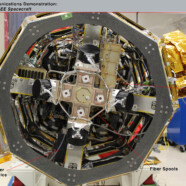NASA to test laser communication system
Laser communications one of the several techs NASA is focused on for deep space missions
The SpaceX cargo spacecraft, which will carry equipment needed for astronauts on the International Space Station to test optical laser communications, is scheduled to launch today.

Lunar Laser Communication Demonstration (LLCD) components integrated onto the Lunar Atmosphere and Dust Environment Explorer (LADEE) spacecraft. (Credit: NASA)
The SpaceX Dragon cargo craft’s scheduled launch on Monday was scrubbed because of a helium leak in the Falcon 9 rocket that will carry it aloft. The mission is now set to launch 3:25 Eastern time on Friday.
If the Friday launch is postponed, another window opens on Saturday.
Optical laser communications, also dubbed lasercom, is one of the emerging technologies that NASA is focused on trying out.
With lasercom, data is transmitted via laser beams; the technology potentially offers much higher data rates than the space agency is able to achieve with current radio frequency transmissions.
“Optical communications have the potential to be a game-changer,” said mission manager Matt Abrahamson, in a statement. “It’s like upgrading from dial-up to DSL. Our ability to generate data has greatly outpaced our ability to downlink it. Imagine trying to download a movie at home over dial-up. It’s essentially the same problem in space, whether we’re talking about low-Earth orbit or deep space.”
Abrahamson noted that many of the latest deep space missions send data back and forth at 200 to 400 kilobits per second. The new laser technology is expected to transmit data at 50 megabits per second.
Since one megabit is equal to 1,024 kilobits, that means the new communications should be up to 256 times faster.
Once the Dragon spacecraft rendezvouses with the space station, the orbiter’s robotic arm will remove it from the ship’s cargo bay and then attach it to the outside of the station. The laser test is expected to last at least three months.
A ground telescope will be used to test the new communication tool.
As the space station moves in its orbit around Earth, the ground telescope will track it and transmit a laser beacon carrying a video uplink in 100-second bursts to the orbiting instrument. The tests will help scientists better calculate the ability to point the laser, along with beam acquisition and tracking — all while the space station is traveling at approximately 17,500 miles per hour.
The new laser communications initiative is a key part of NASA’s Space Technology Mission Directorate, an arm of the space agency focused on developing technology for future space missions, as well as for life here on Earth.
On Wednesday, Michael Gazarik, NASA’s associate administrator for space technology, laid out the agency’s main goals for the next several years.
One is to finish building the Orion spacecraft, which is expected take astronauts back into space from U.S. soil and on to asteroids, the moon and Mars.
Other efforts include building high-power in-space solar propulsion systems, oxygen recovery systems, thermal protection systems, robotics and optical communication systems, like the lasercom system that will be tested on the space station.
The solar propulsion system includes a 31-foot deployable solar panel array, which NASA first tested on the ground last month.
Gazarik noted that today’s state-of-the-art solar arrays aren’t very efficient and NASA is looking to make changes so the arrays can be used to power spacecraft.
“This could change the way the nation operates and moves in space,” he said.
In terms of robotics, Gazarik said the robotic rovers Spirit and Opportunity, which have been used to study Mars, needed 10 years to drive about 10 kilometers on the Red Planet.
Now NASA is working on robotic rovers that will be able to drive that far on Mars in a single week.
Source: Sharon Gaudin

